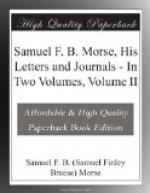It was at first hoped that the unveiling might take place on the 27th of April, 1871, Morse’s eightieth birthday; but unavoidable delays arose, and it was not until the 10th of June that everything was in readiness. It was a perfect June day and the hundreds of telegraphers from all parts of the country, with their families, spent the forenoon in a steamboat excursion around the city. In the afternoon crowds flocked to the park where, near what is now called the “Inventor’s Gate,” the statue stood in the angle between two platforms for the invited guests. Morse himself refused to attend the ceremonies of the unveiling of his counterfeit presentment, as being too great a strain on his innate modesty. Some persons and some papers said that he was present, but, as Mr. James D. Reid says in his “Telegraph in America,” “Mr. Morse was incapable of such an indelicacy.... Men of refinement and modesty would justly have marvelled had they seen him in such a place.”
At about four o’clock the Governor of New York, John T. Hoffman, delivered the opening address, saying, in the course of his speech: “In our day a new era has dawned. Again, for the second time in the history of the world, the power of language is increased by human agency. Thanks to Samuel F.B. Morse men speak to one another now, though separated by the width of the earth, with the lightning’s speed and as if standing face to face. If the inventor of the alphabet be deserving of the highest honors, so is he whose great achievement marks this epoch in the history of language—the inventor of the Electric Telegraph. We intend, so far as in us lies, that the men who come after us shall be at no loss to discover his name for want of recorded testimony.”
Governor Claflin, of Massachusetts, and William Orton, president of the Western Union Telegraph Company, then drew aside the drapery amidst the cheers and applause of the multitude, while the Governor’s Island band played the “Star-Spangled Banner.”
William Cullen Bryant, who was an early friend of the inventor, then presented the statue to the city in an eloquent address, from which I shall quote the following words:—
“It may be said, I know, that the civilized world is already full of memorials which speak the merit of our friend and the grandeur and utility of his invention. Every telegraphic station is such a memorial. Every message sent from one of these stations to another may be counted among the honors paid to his name. Every telegraphic wire strung from post to post, as it hums in the wind, murmurs his eulogy. Every sheaf of wires laid down in the deep sea, occupying the bottom of soundless abysses to which human sight has never penetrated, and carrying the electric pulse, charged with the burden of human thought, from continent to continent, from the Old World to the New, is a testimonial to his greatness.... The Latin inscription in the church of St. Paul’s in London, referring to Sir Christopher Wren, its architect,—’If you would behold his monument, look around you,’—may be applied in a far more comprehensive sense to our friend, since the great globe itself has become his monument.”




